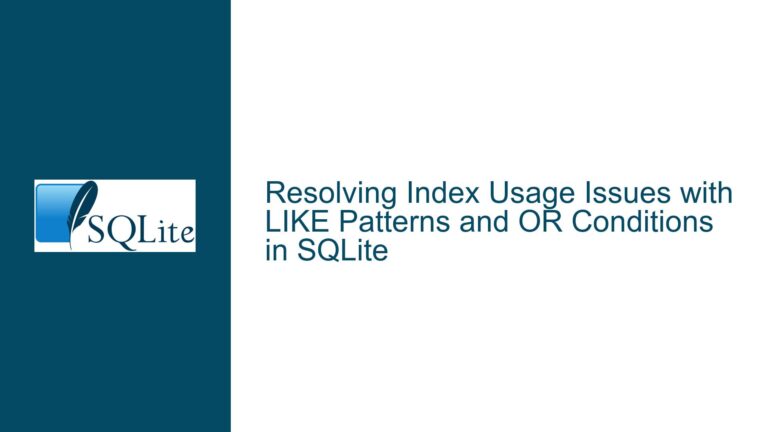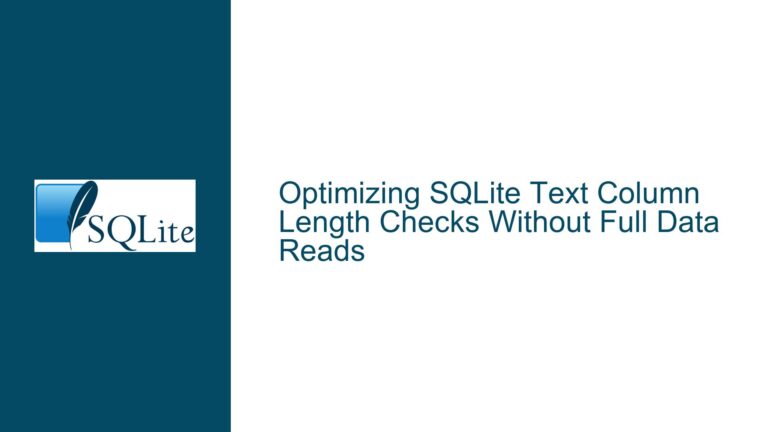Optimizing SQLite Performance with PRAGMA optimize in PHP Web Applications
Understanding PRAGMA optimize and Its Role in SQLite Performance
SQLite is a lightweight, serverless database engine that is widely used in web applications due to its simplicity and ease of integration. One of the key features of SQLite is its ability to optimize query performance through the use of PRAGMA statements. Specifically, PRAGMA optimize is a directive that helps SQLite maintain efficient query execution plans by analyzing the database schema and statistics. This is particularly important in applications where the database schema or data distribution changes over time, as outdated statistics can lead to suboptimal query plans.
In the context of PHP web applications, where database connections are typically short-lived, the use of PRAGMA optimize becomes a point of consideration. The SQLite documentation recommends running PRAGMA optimize just prior to closing each database connection. This recommendation is based on the assumption that the database may have undergone changes during the connection’s lifetime, and running PRAGMA optimize ensures that the query planner has the most up-to-date information.
However, the implementation of PRAGMA optimize in a PHP web application raises several questions. First, is it necessary to run PRAGMA optimize on every connection closure, especially in high-traffic web applications? Second, what are the performance implications of running PRAGMA optimize frequently? Third, are there alternative strategies for maintaining SQLite performance without incurring the overhead of frequent PRAGMA optimize executions?
To address these questions, it is essential to understand the internal workings of PRAGMA optimize. When executed, PRAGMA optimize performs a lightweight analysis of the database, updating the internal statistics that the SQLite query planner uses to determine the most efficient way to execute queries. In most cases, this operation is a no-op or nearly so, meaning it has minimal impact on performance. However, in cases where significant changes have occurred in the database, PRAGMA optimize may trigger a more thorough analysis, which could take longer to complete.
Given this understanding, the decision to use PRAGMA optimize in a PHP web application should be based on the specific characteristics of the application, including the frequency of database changes, the size of the database, and the performance requirements of the application. In some cases, running PRAGMA optimize on every connection closure may be justified, while in others, it may be more appropriate to run it less frequently or as part of a separate maintenance routine.
Evaluating the Impact of PRAGMA optimize on PHP Web Application Performance
The performance impact of running PRAGMA optimize in a PHP web application depends on several factors, including the size of the database, the frequency of database changes, and the workload of the application. In general, PRAGMA optimize is designed to be a lightweight operation, but there are scenarios where it could introduce noticeable overhead.
One of the primary concerns is the potential for PRAGMA optimize to slow down the response time of the web application. If the database is large or has undergone significant changes, PRAGMA optimize may need to perform a more thorough analysis, which could take longer to complete. This could result in increased latency for web requests, particularly in high-traffic applications where database connections are frequently opened and closed.
Another consideration is the impact on database connection pooling. In many PHP web applications, database connections are managed using a connection pool, which allows multiple requests to share a limited number of database connections. If PRAGMA optimize is run on every connection closure, it could reduce the availability of connections in the pool, leading to increased contention and potentially slower response times.
To mitigate these concerns, it is important to evaluate the specific performance characteristics of the application. One approach is to conduct an A/B test, comparing the performance of the application with and without PRAGMA optimize. This can help determine whether the benefits of running PRAGMA optimize outweigh the potential performance costs.
In addition to A/B testing, it may be useful to monitor the performance of the database over time, particularly after significant changes to the schema or data distribution. This can help identify situations where PRAGMA optimize is most beneficial and allow for more targeted use of the directive.
Implementing PRAGMA optimize in PHP Web Applications: Best Practices and Alternatives
When implementing PRAGMA optimize in a PHP web application, there are several best practices and alternative strategies to consider. These approaches can help balance the need for maintaining optimal query performance with the potential performance overhead of running PRAGMA optimize frequently.
One best practice is to run PRAGMA optimize selectively, rather than on every connection closure. For example, PRAGMA optimize could be run only after significant changes to the database, such as after a batch insert or update operation. This approach reduces the frequency of PRAGMA optimize executions, minimizing the potential performance impact while still ensuring that the query planner has up-to-date statistics.
Another strategy is to run PRAGMA optimize as part of a separate maintenance routine, rather than within the web application itself. This could involve scheduling a cron job or using a task scheduler to run PRAGMA optimize during periods of low traffic, such as late at night or on weekends. This approach allows for more thorough analysis of the database without impacting the performance of the web application during peak usage times.
In some cases, it may be appropriate to use alternative methods for maintaining query performance, rather than relying on PRAGMA optimize. For example, the ANALYZE command can be used to manually update the statistics for specific tables or indexes. This can be particularly useful in situations where only a subset of the database has changed, allowing for more targeted optimization.
Additionally, it is important to consider the overall design of the database schema and the queries used in the application. Proper indexing, normalization, and query optimization can reduce the need for frequent PRAGMA optimize executions by ensuring that the query planner has efficient execution paths from the outset.
Finally, it is worth noting that the use of PRAGMA optimize should be guided by the specific requirements and characteristics of the application. In some cases, the benefits of running PRAGMA optimize may outweigh the potential performance costs, while in others, alternative strategies may be more appropriate. By carefully evaluating the impact of PRAGMA optimize and implementing it in a targeted and thoughtful manner, it is possible to maintain optimal query performance in PHP web applications using SQLite.
Conclusion
In summary, the use of PRAGMA optimize in PHP web applications using SQLite is a nuanced decision that requires careful consideration of the application’s performance requirements and database characteristics. While PRAGMA optimize can help maintain efficient query execution plans, its impact on performance should be evaluated through testing and monitoring. By implementing PRAGMA optimize selectively, using alternative optimization strategies, and adhering to best practices in database design and query optimization, it is possible to achieve a balance between maintaining optimal query performance and minimizing the performance overhead of PRAGMA optimize.






